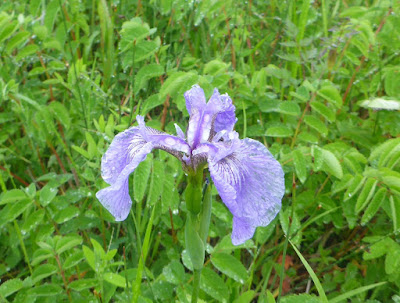Driving southwest we passed barren lands made of limestone.
Newfoundland and Labrador became a province of Canada following WWII in March of 1949. Many of the roads were initially built in the 1960's. The growing season is especially short in the northern part of Newfoundland and the soil is shallow or composed of peat. After the roads were built in the late 60's in this area, garden plots were planted along the roadside where soil had been hauled in as part of the road building process. These gardens may be 10 miles or more from the nearest home. We are not sure when they are tended but most of them look well kept. Mostly there are potatoes growing but once and a while you see cabbage and turnip.
There was a huge area of vetch today when we stopped for a break.
Wild strawberries were growing there too.

There was a sled for hauling wood there too.
Underground Salmon Pool - Near the top of the Northern Peninsula, a few miles before Roddickton, NL, a sign points to the right on a gravel road, and eventually to a parking area, with signs showing trails. These will take you to Beaver Brook. The trail is not strenuous, but about 1.5 km. to the brook. Called a brook, but really more of a small river, it travels through an underground cavern - that is also the upstream route of Atlantic salmon travelling to spawning areas.
If water conditions are appropriate, and there is mid-day light down into the tannin-brown water, Atlantic salmon can be seen lazing below or above the cavern. - Thanks goes to the Atlantic Salmon Federation for this information.
Allan gets credit for this picture that he took of the pool just before the salmon swim underground. We counted over a dozen salmon at any given time in this pool. Brian said that they were good sized and several were very big. There were three people fly fishing down below the pool on the river.
Brian was itching to fish but because he is a nonresident he can only fish with a guide.
The view on the way to the underground salmon pool.
The Smith's van coming back out to the main road following our salmon pool visit.
We proceeded south and west and drove down that shore.
Apparently at some point in the year they lobster here.
Our next stop was to visit the Torrent River Salmon Interpretive Centre - It is in Hawke's Bay a short distance from the main road. This boardwalk takes you from the parking lot to the center. We have come across many boardwalks. The ground has poor drainage and is often moist.
At this site they have displays on the history of Atlantic salmon on the Torrent River and an underwater viewing station where you can look into the fishway that leads the salmon around a waterfall.
They have a gate at the top of the fishway and a couple of times a day they open the gate for the fish to continue up the river. When they open the gate they turn on a video camera that records their passage. At a later time the video is viewed and the salmon are counted. In recent days they have had from 53 to 167 salmon swim on by.

This is a picture of them behind the glass swimming in the fishway upstream. Unfortunately my camera flashed which is probably not good for the fish and not great for the picture.
Allan captured this shot of a salmon trying to make it up and over the falls. I doubt that he experienced success until he swam up the fishway, by the viewing spots and past the video camera.
Driving on down the coast we stopped at The Arches Provincial Park. These naturally formed arches were created over the ages by tidal action.
Here is my favorite back up photographer and chauffeur.
Mother nature is quite powerful and grand.
This is just a sample of the variety of shapes, color and sizes of the stones at this location.
As we continued to Cow Head we could see the Long Range Mountains on our left and the Atlantic Ocean on our right. This tree in the foreground is representative of the trees along this shoreline. We were on a high bluff for much of our ride along the ocean today. You can see the effect that the strong persistent wind from the ocean has had on its growth.
We will be here in Cow Head for two nights. Our room faces Shallow Bay. Just now at 9:36 pm we are experiencing a beautiful sunset.




















































